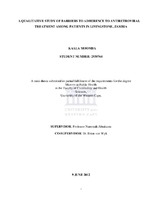| dc.description.abstract | Introduction: Zambia is among the countries in the sub-Saharan African region most severely affected with HIV/AIDS. Approximately 1.2 million (14%) Zambians were living with HIV in 2010. Zambia introduced antiretroviral therapy (ART) in the public sector in 2002, starting with two pilot sites, and rolling it out throughout the country in 2004 and 2005. To date,approximately 350,000 people have accessed HIV treatment. The long-term success of ART programs depends on optimal adherence to ART by patients.In 2010 Livingstone General Hospital (LGH), the setting for the current research had over 7,000 enrolled for HIV care of whom 3,880 patients were on ART. By the end of June 2011, it was reported that 343 patients in this hospital were between 2 to 30 days late for their medication refill appointments. This meant that these patients had missed more than one dose, and thus not meeting the required 95% of medication for viral suppression. This study explored the barriers to medication adherence experienced by ART patients at Livingstone General Hospital (LGH). Methodology: An exploratory qualitative study was conducted. Six focus group discussions(FGD) were conducted with 42 patients on ART, and follow up semi-structured interviews with 7 patients identified during the FGDs. FGDs and semi-structured interviews were audio-tape recorded and transcribed verbatim. Thematic and content analysis of transcribed data was done. Results: The study found that the barriers to ART adherence included socio-economic factors such as poverty, use of traditional complementary and alternative medicines (TCAM) and religious beliefs. Patient related factors reported to negatively affect adherence were HIV related-stigma and discrimination, alcohol use, low literacy and education levels, busy daily schedules and forgetfulness. Regimen related factors included experiencing side effects to medication and complexity of treatment regimen. Negative staff attitudes, traveling long distances to health facility, long waiting times, lack of confidentiality, poor health information and poor patient-health provider relationships were the health system factors that negatively impacted on ART adherence. Conclusion: The combination and complexity of factors affecting adherence identified in this study have posed a challenge to adherence to ART. People have been forced to make adjustments to their routine lives in order to accommodate ART. The most problematic factor identified was the use of TCAM in combination with ART or as replacement of ART. | en_US |

